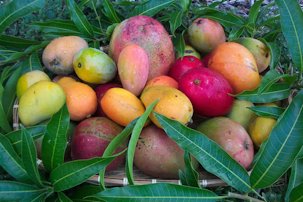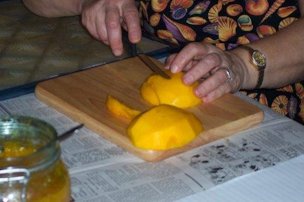Fairchild Tropical Botanic Garden
by Noris Ledesma
Curator of Tropical Fruit
Mango Season -
Just Satisfying!
As
published in the Miami Herald
Preserving
Mangos
With
mango season here, we are all thinking about that age-old question: how
to deal with all those glorious, delicious—and
ripe—mangos.
There is the only one mainland area of the United States where this
delicious and fragrant fruit can be properly grown. For years mangos
have been of great value in South Florida, grown with pride in the
garden - a fruit to eat when ripe and at all stages of growth. Fresh
mangos are a privilege Floridians have. Nothing compares the delicacy
of a fresh mango harvested directly from the tree.
Mangos can
also be an important part of healthy eating. Work fruits into the daily
routine, aiming for the goal of at least five servings a day. Be sure
to serve fruit at every meal. Since this is mango season, if you have
mango trees in your yard, use them or buy your mangos from local
Farmers’ Markets, it is a great way to get fresh, tasty
produce
and support our local farmers.
If you own a mango tree, keep in
mind that among mangos there is a wide variety of color, shape, flavor,
texture, aroma and uses. Many of the mango varieties are best just as
they come off the tree, fresh and succulent – the perfect
summer
snack. Others are at their best in combinations with the exciting
flavors of South Florida, spawning a taste experience found no where
else in the world.
Because mangos come in a rainbow of reds,
yellows, oranges, and greens, color is not the best way to determine
ripeness. Determining the proper ripeness of the fruit is best done
with your hands or with your nose, with a gentle give and fruity aroma
hinting at the heaven that waits inside. As for ripening, it is Mother
Nature that knows best, providing a warm room temperature for the
perfect conversion of starch to sugar.

A
delightful way to serve a mango is the exquisite Indian mango
‘Dusehri’ served whole with the skin peeled back.
It can
be placed in a cup or just simply held in the hand like a lollipop;
kids will love it.
Children, especially younger ones, will eat
what’s available at home. That’s why it’s
important
to control the supply lines — the foods that you serve for
meals
and have on hand for snacks. Make it easy for your child to choose
healthy snacks by keeping fruits ready to eat. Encourage healthy
choices by eating well yourself. Kids will follow the lead of the
adults they see every day.
Freezing
Mangos
One
of the advantages of preserving mangos is to have them available for
consumption over a longer period of time. By freezing mangos, one is
able to utilize all of the fruit in a single season.

Procedure:
Select quality fruit: Select firm, ripe fruit. Carefully wash and peel
the fruit.
Cut the fruit into lengthwise slices.
Pour the pulp in plastic bags.
Freeze.
Freezing
mangos is accomplished by storing fruit at temperatures bellow 32F.
This limits the enzymatic breakdown of the fruit. Mangos can be frozen
without any special treatment except washing, while some fruits need to
be peeled or seeded. Frozen mango pulp looks and tastes very similar to
fresh fruit. The pulp can be used in smoothies, jellies, chutney,
bread, ice cream and more. After a year it may change the color, but
the flavor still good, and perfect to make mango chutney.
Drying Mangos

Select
ripe mangos that are firm. Peel the fruit, and cut off the two sides.
Cut the pieces of pulp into lengthwise slices 1/4 to 1/2 inch
thick. Arrange the slices flat on the dehydrating trays. Place the
trays in the dehydrator. Set the temperature control from 125º
to
135ºF, and let it run until the slices reach the desired
consistency. Slices that are too soft or moist do not store well.
Drying time depends upon the thickness of the slices, the amount of
fruit in the dehydrator and the humidity. In South Florida, drying
times of 8 to 10 hours are typical. However, check a few hours earlier
because it can burn the fruit. Proper dried slices have a beautiful
golden-yellow color.
Preservation
of Mango Fruit by Drying
Drying
(dehydration) is an excellent way to preserve surplus mango fruit. In
the form of dried slices or fruit leather, the mango makes a delicious,
sweet, all-natural snack. In regions where there is little rain and low
atmospheric humidity, the fruit can be dried in the sun. The climate in
South Florida, however, is too rainy and humid during the mango season
for sun-drying to be practical. Electric dehydrators are the most
convenient method for drying mangos here.

Several
good dehydrators are available. Those made by Excalibur have
rectangular trays and the largest capacity. In this machine, the air
flows across the trays, not through them. This keeps the flavors of
different fruit or vegetables from mixing. Other good machines are made
by Waring and American Harvest. These have circular trays. The best
machines have an electric heating element with an adjustable
temperature control, a fan which assures uniform temperature
distribution in the drying chamber, and adequate vents to facilitate
air circulation. Teflon mesh trays are superior to metal or other kinds
of plastic because the dried fruit slices do not stick to them. The
oven of a household cooking stove (electric or gas) can be used for
drying fruit also, provided that the temperature can be set low enough
to prevent darkening of the fruit. A convection oven works more like an
electric dehydrator because a fan circulates the air and hastens drying.
For
drying slices, select ripe fruit that yields to the pressure of the
fingers on the surface, but is still relatively firm. Avoid fruit which
are too soft and mushy because they are difficult to slice and will
result in slices that are dark in color. Peel the fruit with a sharp
knife and cut out any defective parts. Cut off the two sides or
“cheeks” of the pulp, and then the two remaining
narrow
pieces from the edges of the seed. Discard the peels and seeds with the
compost.
Cut the pieces of pulp into lengthwise slices of
1/4 to d inch thickness. Arrange the slices flat on the drying
trays. For home use it is not necessary to use any additives on the
slices. Place the trays in the dehydrator. Set the temperature control
to 125 to 135ºF, turn on the dehydrator, and let it run continuously
until the slices reach the desired consistency. Most people prefer
slices with a leathery, but not hard or brittle consistency. Slices
that are too soft and moist do not store well. If freshly dried slices
are too brittle, place them in an open container and let them stand at
room temperature and humidity until the slices are the right
consistency. Drying time depends upon the thickness of the slices, the
amount of fruit in the dehydrator, and the atmospheric humidity. In
South Florida, drying times of 8 to 10 hr usually are satisfactory.
However, slices should be checked a few hours prior to the expected
completion time, as drying too long wastes electricity and can burn the
fruit. Proper dried slices have a beautiful golden-yellow color. Slices
dried too long often will have a brown color, which most people
consider undesirable.
For mango leather, select fully ripe
fruit. The pulp should be soft enough to make into a puree easily. Peel
the fruit and cut the pulp from the seed. Place the pulp in a blender
or colander and make it into a smooth puree. No additives are needed.
Place sheets of thin plastic (Saran wrap) on the dehydrator trays or on
cookie sheets for drying in the oven. Spread the puree on the sheets in
a layer about 1/4 inch thick. Place the trays in the
dehydrator
with the temperature control set to 125 to 130ºF. Turn on the
dehydrator and let it run until the leather has reached a firm,
elastic, sticky consistency. The time required should be 8 to 10 hours.
The leather is considered finished when the dried pulp can be easily
peeled from the plastic. Dried mango leather usually develops a darker
color than dried slices (light to dark brown). Remove leather from the
trays and roll it up in the plastic sheets. Leather rolls which are not
covered will stick together.
Dried mango slices or leather
should be placed in closed bags soon after drying. If they are left in
a humid atmosphere without protection they will take up moisture and
soften considerably. The bags of dried slices or leather should not be
stored at room temperature for more than a few days in hot weather, as
they will ferment or develop mold on their surface and become inedible.
Dried mango products can be kept in a refrigerator successfully for at
least two years, or in a freezer for at least three years.
Don't waste your mangos, you can enjoy them all year around!
Back to
Mango
Page
|
|



